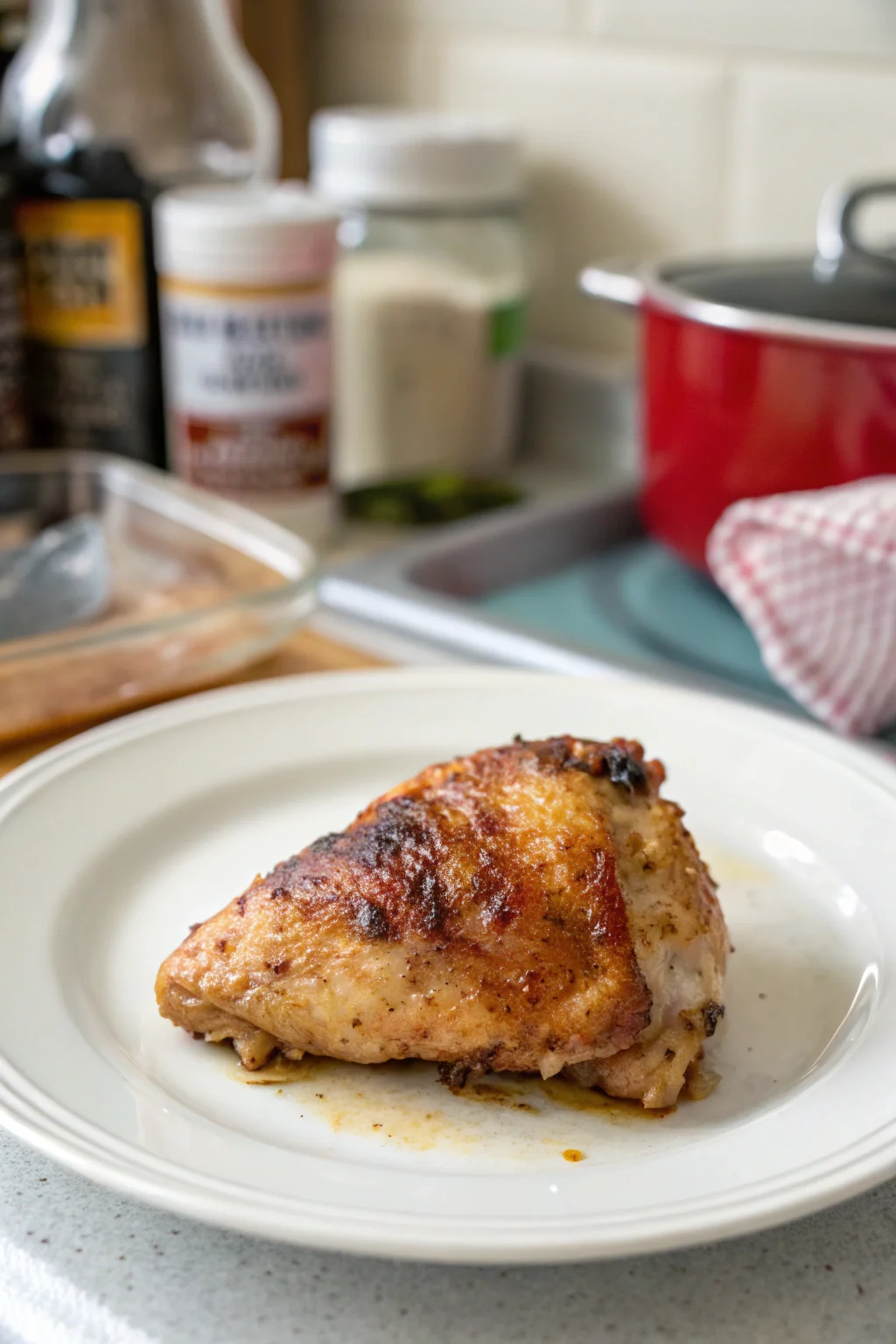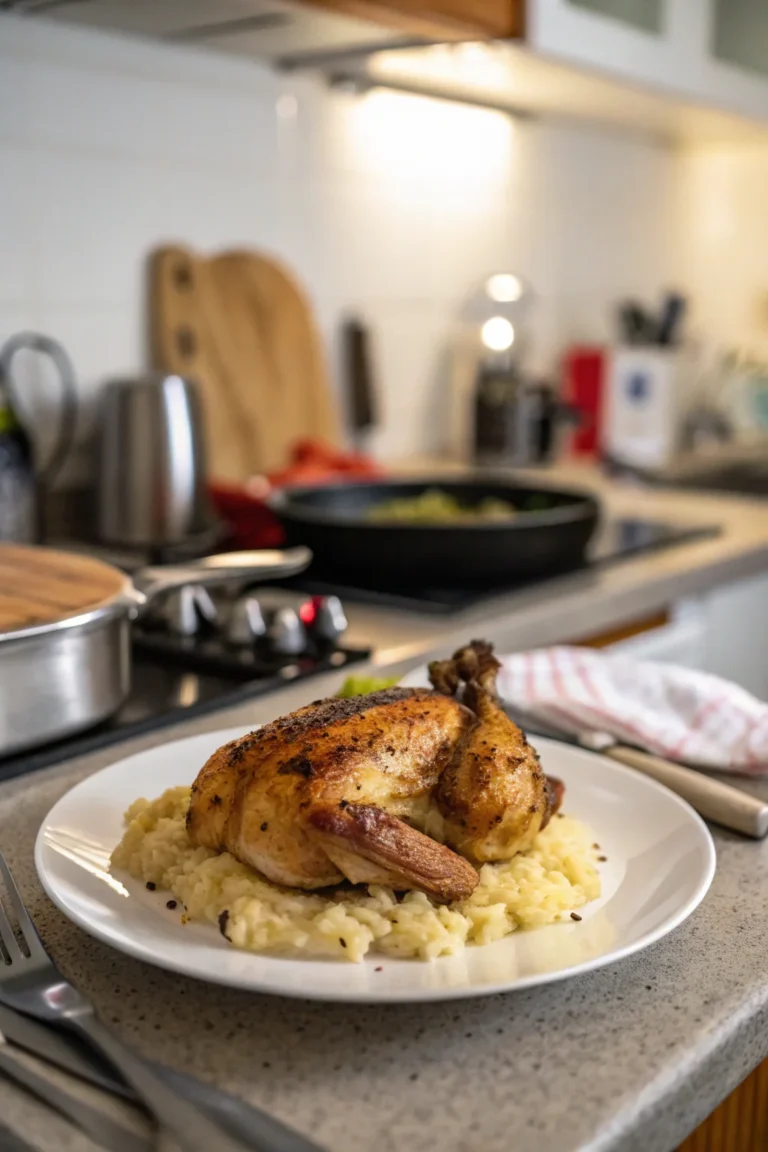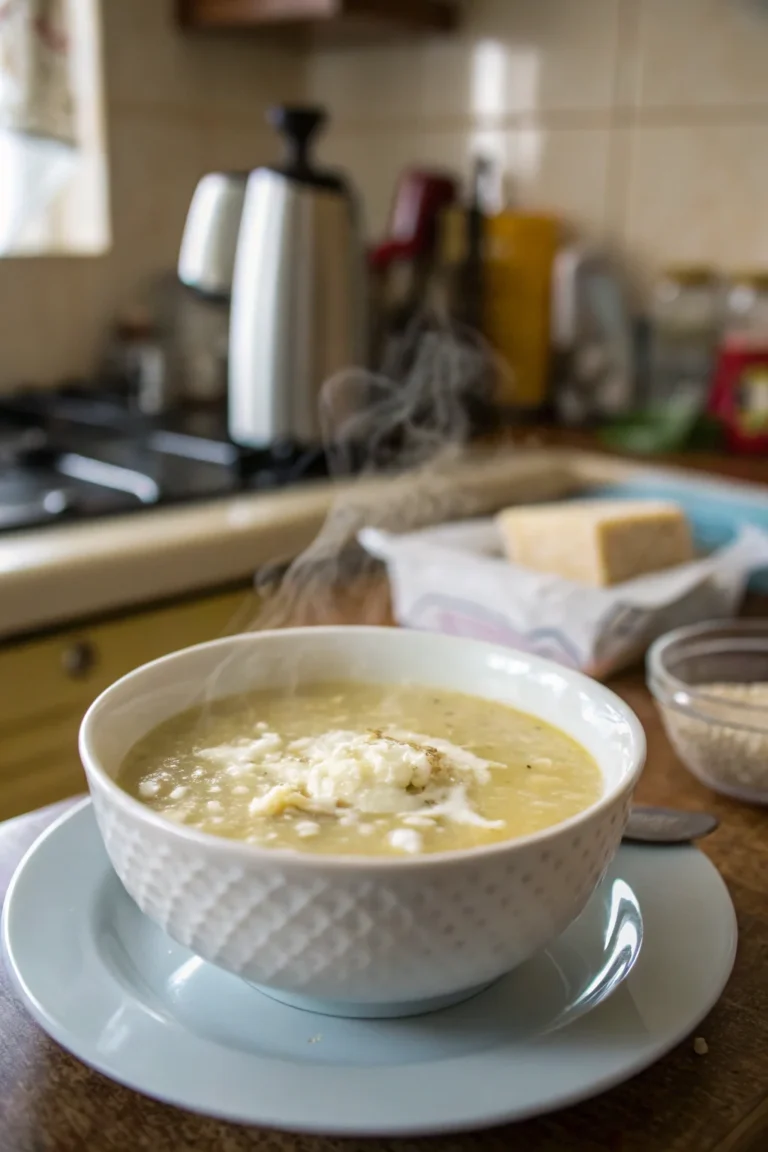Why Is My Chicken Dry After Baking? | Tips for Juicy Chicken
Baking chicken dry can seem straightforward, but ending up with dry meat is a common issue many home cooks face. Understanding why your chicken turns out dry can help you make adjustments for a juicier result. This guide answers common questions about this cooking dilemma and offers practical tips to help you bake perfectly moist chicken every time.
Table of Contents
Why Does My Chicken Turn Out Dry After Baking?

Chicken can dry out when baked if it’s overcooked, cooked at too high a temperature, or not properly prepared. Overcooking is the most common cause because it causes the proteins in the meat to tighten and expel moisture. Additionally, cooking at a very high temperature can lead to rapid moisture loss. The key is to strike a balance between temperature and time.
To prevent this, try these tips: – Use a Meat Thermometer: This is arguably the most reliable method to ensure your chicken is cooked perfectly without being overdone. Insert the thermometer into the thickest part of the chicken, avoiding bones, to check for an internal temperature of 165°F (74°C). It’s a small investment that can significantly improve your cooking results. In fact, it takes the guesswork out of cooking, providing precision that is especially helpful for novice cooks. – Brine the Chicken: Soak it in a saltwater solution before baking to help retain moisture. A basic brine can consist of 1/4 cup salt dissolved in 4 cups of water. You can add sugar, herbs, or spices for extra flavor. The brining process helps the chicken absorb extra liquid and salt, which results in a juicier product. This method is particularly useful for lean cuts like chicken breasts, which tend to dry out more easily. – Cover with Foil: This can help trap steam and moisture during cooking. If you’re baking a whole chicken, tent it with foil after the first half of the cooking time. This allows the chicken to cook through without losing moisture, but remember to remove the foil during the last 10 minutes if you want a crispy skin. This technique also helps in even cooking by preventing the exterior from drying out before the interior is fully cooked.
What Temperature Should I Bake Chicken To Keep It Juicy?
The ideal temperature to bake chicken is 350°F (175°C). This moderate temperature allows the chicken to cook evenly without drying out. Cooking at a lower temperature for a longer period can also help retain moisture, especially for larger cuts. For instance, baking a whole chicken at 325°F (163°C) for a longer time can result in incredibly tender meat. Always use a meat thermometer to ensure the internal temperature reaches 165°F (74°C) for safe consumption.
Some cooks prefer to start with a higher temperature to achieve a crispy skin, then lower it to allow the meat to cook through gently. For example, you can start at 425°F (218°C) for 10-15 minutes, then reduce to 350°F (175°C) for the remainder. This method requires careful monitoring to prevent overcooking.
How Can I Tell If My Chicken Is Overcooked?
Overcooked chicken is often dry and stringy. To check if your chicken is overcooked: – Texture Test: Overcooked chicken feels firm and lacks juiciness. Press down on the meat; it should feel slightly springy. If it’s too firm, it’s likely overdone. You can compare it to the touch of your palm below your thumb; it should give slightly but not be mushy. – Cut and Check: Slice into the thickest part; if the juices run clear and the meat is white, it’s usually done. Be cautious though; if your chicken has a pink tinge but the temperature is right, it may still be safe to eat due to the myoglobin in the meat, which can sometimes retain a pink color. The USDA notes that as long as the chicken reaches the safe temperature, a pink hue is not necessarily a sign of undercooking. – Use a Thermometer: The absence of pink in the meat and a temperature of 165°F (74°C) indicate it’s cooked properly. This is the best method to ensure safety and juiciness, as the thermometer takes the guesswork out of the equation. Remember to allow for carryover cooking, where the meat continues to cook slightly after being removed from the oven.
Should I Marinate Chicken Before Baking?
Yes, marinating chicken can add flavor and help keep it moist. Marinades typically contain acid (like lemon juice or vinegar), oil, and seasonings. The acid and oil help tenderize the meat and lock in moisture. Marinate the chicken for at least 30 minutes, or up to 24 hours for more intense flavor. Remember, if you’re using a marinade with a high acid content, longer isn’t always better. Too much marination can lead to mushy meat, so balance is key.
When preparing a marinade, consider the flavor profile that complements your dish. For an Asian-inspired chicken, use soy sauce, ginger, and garlic. For a Mediterranean twist, use olive oil, lemon, and oregano. Always marinate in the refrigerator to ensure food safety, and discard any leftover marinade that has been in contact with raw chicken to avoid cross-contamination.
Does Brining Help Keep Chicken Juicy?

Absolutely, brining is one of the best methods to ensure juicy chicken. Brining involves soaking the chicken in a saltwater solution, which helps the meat absorb water and seasoning. This process breaks down some of the muscle fibers, making the chicken more tender when cooked. Ideally, brine for 1 to 2 hours before baking. If you’re short on time, even a quick 30-minute brine can make a noticeable difference.
For those looking to add more flavor, consider enhancing your brine with aromatics like bay leaves, peppercorns, or even a splash of apple cider. These additions infuse the meat with subtle flavors that elevate the overall taste without overpowering it.
Can I Use a Slow Cooker to Avoid Dry Chicken?
Yes, using a slow cooker can help maintain moisture in chicken. Slow cooking at a low temperature allows the meat to cook slowly, resulting in tender, juicy chicken. Be sure not to overfill the slow cooker, and add a bit of broth or water to assist in moisture retention. You can also layer the bottom of the cooker with vegetables like onions and carrots, which can add flavor and moisture.
Using a slow cooker is particularly beneficial for tougher cuts or when cooking chicken with bones, as the extended cooking time allows the meat to become tender and flavorful. Just be cautious not to exceed the recommended cooking time, as even in a slow cooker, chicken can eventually dry out if left too long.
Is It Better to Bake Chicken Covered or Uncovered?
Baking chicken covered can help trap moisture and prevent it from drying out. Covering with foil or a lid keeps steam in, creating a humid cooking environment. Remove the cover during the last 10 minutes of cooking if you prefer a crispier skin. Another approach is using a baking dish with a lid or an oven-safe pot, which can create a similar effect to braising, keeping the chicken moist and flavorful.
When deciding whether to cover or uncover your chicken, consider the type of dish you’re preparing. For example, a casserole-style dish may benefit from being covered most of the time, while a roasted chicken might be best uncovered towards the end to develop a crisp, golden skin.
How Do I Keep Chicken Breast Moist When Baking?
Keeping chicken breast moist involves: – Brining or Marinating: As mentioned, this adds moisture and flavor. For a quick marinade, try olive oil, lemon juice, garlic, and your choice of herbs. This combination not only enhances flavor but also ensures the chicken remains juicy. – Basting Regularly: Spoon the cooking juices over the chicken during baking. This helps keep the surface moist and can infuse additional flavor into the meat. If you’re using a roasting pan, you can tilt it slightly to pool juices in one corner, making basting easier. – Rest After Cooking: Let the chicken rest for 5-10 minutes before cutting to allow juices to redistribute. This step is crucial, as it ensures the moisture that has moved to the center during cooking gets a chance to spread back through the meat. Resting also makes carving easier, as the meat firms up slightly during this time.
What Are the Best Seasonings for Juicy Baked Chicken?
Proper seasoning can enhance flavor and help in retaining moisture. Consider: – Herbs: Such as rosemary, thyme, and basil. These can be used fresh or dried and work wonderfully when combined with olive oil and lemon. Fresh herbs add a vibrant flavor, while dried herbs offer a more concentrated taste. – Spices: Like paprika, garlic powder, and onion powder. These add depth of flavor and a bit of color. For a smoky touch, consider using smoked paprika or chipotle powder. – Citrus: Lemon zest or juice adds moisture and brightness. You can also try orange or lime for a different twist. Citrus not only adds a burst of flavor but helps in tenderizing the meat. Zesting the fruit releases essential oils, providing a more aromatic experience.
Experiment with spice blends like Cajun or Mediterranean mixes to keep your meals varied and exciting. These can be made in bulk and stored for quick use.
How Long Should I Bake Chicken?
The baking time depends on the chicken cut. Generally: – Breasts: 20-30 minutes at 350°F (175°C). Thinner breasts may require less time, so check them early to avoid overcooking. Butterfly thicker breasts for more even cooking. – Thighs: 35-45 minutes at 350°F (175°C). Thighs are more forgiving due to their higher fat content, which helps keep them moist. They can also be cooked at a slightly higher temperature for a shorter time if you’re looking for crispy skin. – Whole Chicken: Approximately 20 minutes per pound at 350°F (175°C). For an average 4-pound chicken, this means about 1 hour and 20 minutes. Always verify doneness with a thermometer. Consider trussing the chicken to ensure even cooking and a more attractive presentation.
Adjust cooking times based on your specific oven, as some may run hotter or cooler than the indicated temperature. Using an oven thermometer can help ensure accuracy.
What Role Does Resting Play in Chicken Juiciness?
Resting allows juices to redistribute throughout the meat. If you cut into the chicken immediately after baking, the juices can escape, leading to dryness. Let chicken rest for about 5-10 minutes before serving. This step is essential for achieving the ideal texture and moisture level, as it allows the muscle fibers to relax and reabsorb some of the lost juices.
During this resting period, cover the chicken loosely with foil to retain heat. This ensures the meat remains warm while allowing the juices to settle back into the flesh, enhancing the overall taste and succulence.
Is Bone-In Chicken Better for Juiciness?
Yes, bone-in chicken pieces tend to be juicier than boneless ones. The bone helps insulate the meat, allowing it to cook more evenly and retain moisture. Skin-on pieces also provide additional protection against drying out. The skin acts as a barrier, trapping moisture inside, and also adds flavor and crispness when properly cooked.
When preparing bone-in chicken, consider using it in dishes where the bone can contribute additional flavor, such as stews or braises. The marrow within the bones can add richness to the cooking liquid, enhancing the overall dish.
What Are Some Common Mistakes When Baking Chicken?
Avoid these mistakes to keep chicken juicy: – Skipping Brining/Marinating: Missing out on flavor and moisture retention. Even a simple salt and pepper rub can make a difference if you’re short on time. Include a little oil in the rub to promote even browning. – Overcooking: Use a thermometer to prevent this. Remember, chicken continues to cook after it’s removed from the oven due to residual heat, so aim for a temperature slightly below 165°F (74°C) if you’ll be letting it rest. This is known as carryover cooking and can add several degrees to the final temperature. – Not Covering: Leaving chicken uncovered can lead to moisture loss. If you prefer a crispy skin, uncover for the last few minutes of cooking, but keep it covered initially to retain moisture. Consider using a parchment paper cover if you want to avoid using foil.
Wrap-Up
Achieving juicy baked chicken is all about controlling temperature, time, and preparation techniques like brining and marinating. By understanding these factors, you can easily transform your chicken dishes into succulent meals every time. For more cooking tips, check out our guide to perfect chicken or explore reputable cooking resources for more inspiration. Consider experimenting with different flavors and techniques to find what works best for your taste and style, and soon you’ll be serving up chicken that’s perfectly cooked and bursting with flavor.
Remember, practice makes perfect. Each attempt brings you closer to mastering the art of baking juicy chicken, making every meal delicious and satisfying for you and your loved ones.






